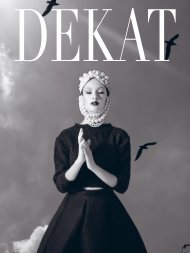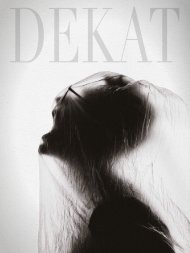1
Create successful ePaper yourself
Turn your PDF publications into a flip-book with our unique Google optimized e-Paper software.
The novelty of Sibusiso Mbhele’s large wire and sheet metal helicopters and aeroplanes, some big enough for him to live in, is best captured in the documentary film by Koto Bolofo<br />
(2000). While running around with the smaller planes held high above his head, Mbhele inadvertently invokes dreams of new possibilities of living in the world. Despite living in a<br />
remote rural community, Mbhele dresses in second-hand fighter pilot overalls or commercial airline pilot uniforms, conveying a multifaceted concept of personal identity to the likeminded<br />
admirers of his movable sculptures.<br />
Titus Matiyane’s bird’s eye view drawings of cities (to date: Polokwane, Durban, Pretoria, London, New York, Hong Kong and Rotterdam) stretch far and<br />
wide, from left to right, sometimes up to 15 metres in length, creating vast panoramas and implicating politicised spaces, especially the South African<br />
cities laid out under apartheid. His ‘eye’ travels in perpetual motion, with the viewer marvelling at the extent of his innovative vision captured in these allencompassing<br />
cityscapes.<br />
The novelty of Sibusiso Mbhele’s large wire and sheet metal helicopters and aeroplanes, some big enough for him to live in, is best captured in the<br />
documentary film by Koto Bolofo (2000). While running around with the smaller planes held high above his head, Mbhele inadvertently invokes dreams<br />
of new possibilities of living in the world. Despite living in a remote rural community, Mbhele dresses in second-hand fighter pilot overalls or commercial<br />
airline pilot uniforms, conveying a multifaceted concept of personal identity to the like-minded admirers of his movable sculptures.<br />
John Phalane also has a bird’s-eye-view of the urban environment, but unlike Matiyane, Phalane views the city from above, vertically, not horizontally from the front.<br />
Previously a taxi driver in Johannesburg, Phalane has an uncanny memory of the street grids of urban planning. He draws the layout of the streets entirely from<br />
memory in a phenomenally expressive mindmap.<br />
Sollie Radile (‘Trolley Man’) collects discarded CDs, DVDs, toys and brightly coloured bric-a-brac that he picks up in the streets for his mobile sculpture, and assembles<br />
to glittering effect in a typical wire shopping trolley. The fish scale-like covering of the trolley sparkles in the sunlight as Radile rambles through the suburbs, creating<br />
a startlingly innovative moveable feast of a sculpture.<br />
The intertextuality of Willie Saayman’s work is a virtual snakes-and-ladders boardgame: he draws on artists and influences as diverse as Jean-Michel Basquiat, Albert<br />
Oehlen, Dana Schutz, Yoshitomo Nara, and Jockum Nordström. He readily embraces the influence of graffiti and street culture, as well as graphic novels and the tattoo<br />
images of Gulag reformatory inmates, vividly captured by Danzig Baldaev.<br />
A recurring motif in his work is the motorcar, bedecked with flags, trailer hooks and mounted machineguns: speed and danger all rolled into a menacing vehicle<br />
careering through his art.<br />
Tito Zungu embellishes the covers of envelopes with ballpoint pen drawings of aeroplanes and ships. He remembers as a young boy being fascinated by these<br />
flying objects and sailing vessels while herding cattle in Stanger on the northern KwaZulu-Natal coast. He believes his letters will be delivered quicker if he affixes an<br />
aeroplane, ship or train to the envelope.<br />
The intertextuality of Willie Saayman’s work is a virtual snakes-and-ladders boardgame: he draws on artists and influences as diverse as Jean-Michel Basquiat, Albert Oehlen,<br />
Dana Schutz, Yoshitomo Nara, and Jockum Nordström. He readily embraces the influence of graffiti and street culture, as well as graphic novels and the tattoo images of Gulag<br />
reformatory inmates, vividly captured by Danzig Baldaev. A recurring motif in his work is the motorcar, bedecked with flags, trailer hooks and mounted machineguns: speed and<br />
danger all rolled into a menacing vehicle careering through his art.<br />
Tito Zungu embellishes the covers of envelopes with ballpoint pen drawings of aeroplanes and ships. He remembers as a young boy being fascinated by these flying objects and<br />
sailing vessels while herding cattle in Stanger on the northern KwaZulu-Natal coast. He believes his letters will be delivered quicker if he affixes an aeroplane, ship or train to the<br />
envelope.<br />
Collectively, South African outsider artists’ work posits a veritable and varied perspective on the land and how its people traversed the terrain in creative and innovative ways. Their<br />
work, combined, constitutes a dynamic, multi-angled, even conceptually cubist view of art in South Africa. Something more than worthy of being included in the art historical cannon<br />
of this country.<br />
306 FOR THE LOVE OF LIGHT<br />
FOR THE LOVE OF LIGHT 307





